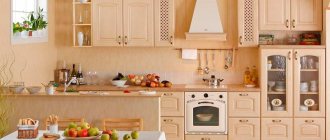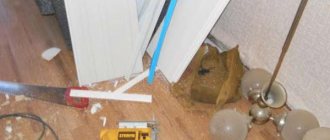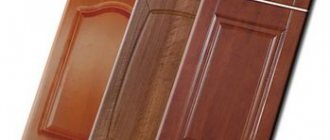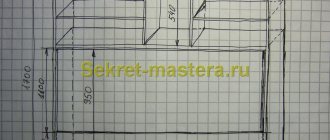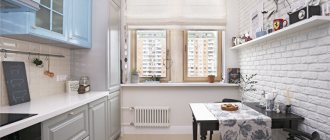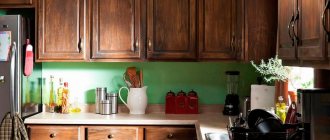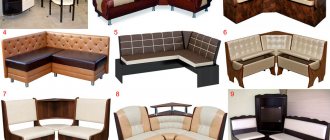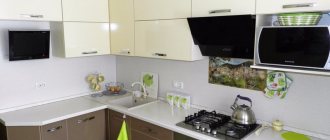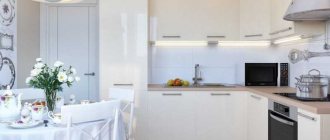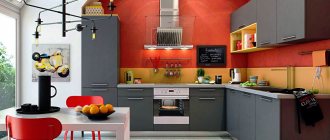Mounting methods
Using dowels is the easiest way to install cabinets on structures made of different materials. In earlier times, corners were used for this purpose. Today this method has lost its relevance. It was replaced by a mounting rail. If the question of how to hang a kitchen cabinet on the wall is being decided, a specific device called a wall mount is also considered.
Mounting rail
The use of such fasteners increases the reliability of the structure. Cabinets are hung on a horizontally oriented strip, which is called a mounting rail. It has several holes. The main task is to mount this element on the wall. All that remains is to secure the cabinets with screws. The advantage of this solution is that there is no need to regularly use a building level to control the position of furniture.
The use of self-tapping screws for point installation of individual cabinets does not provide a long service life. If you fix the furniture using a mounting rail, you can not only quickly mount the set, but also get a structure that will be used for a long period. However, to ensure that the cabinets are level, you will need to carefully check the position of the mounting rail.
Loops
This type of fastener allows you to adjust the position of furniture in the horizontal plane. Installation instructions:
- A cabinet is placed between the previously drawn marking lines. It is held to mark points for installing the dowel.
- A hole is drilled in accordance with the markings.
- Then you need to take the cabinet again and hold it in its original position (between the lines on the wall). The point of the second fastening element is marked. You should first check whether the product is level.
- Install hangers for kitchen cabinets. After this, you can fix the product on the wall.
Hanging on a plasterboard wall
If you try to fix a fairly heavy structure on an unreliable partition, the furniture may collapse after a while. To avoid this, when it is necessary to hang cabinets on a plasterboard wall, the only option considered is mounting on a strip, which is an element of the partition structure. In this case, the weight of the upper part of the headset is transferred to the most reliable area, made of metal. Fixing pieces of furniture is carried out using special dowels.
If you are deciding how to properly hang kitchen cabinets, you should follow the instructions:
- A magnet is used to search for fastening elements in a sheet of drywall.
- Correlate the distance between the nearest screws inside the partition structure and the size that determines the location of the hinges on the cabinets. If necessary, use an intermediate strip for fastening. This method will allow you to redistribute the load across the entire partition.
- Heavy furniture is fixed to the gypsum board wall using anchors and long screws. The partition is drilled through to get to the supporting structure.
How to attach adjustable attachments?
To attach kitchen cabinet hangers, you will need the following tools:
- Drill or hammer drill (depending on the wall material).
- Screwdriver or Phillips screwdriver.
- Hacksaw for metal.
- Level.
- Roulette.
Before proceeding with installation, the following preparatory work should be carried out:
- Make sure the walls are strong if they are finished with plasterboard - secure a wooden beam under the front surface (if possible).
- Form a right angle under the corner cabinet and level the walls. Install the wiring.
- Install a socket for the hood.
Installation of canopies can be done in two ways:
- If the material of the back wall of the cabinet is fiberboard, then small holes will need to be cut in the upper corners for the passage of the mounting tabs. After this, the suspension is pressed against the top shelf and fixed with self-tapping screws to the side.
- If the wall material is laminated chipboard, a cutout will need to be made directly under the canopy.
Attention
Before you begin hanging cabinets, you should loosen the fastening tab until it can move up and down freely. This will greatly facilitate the adjustment process after the canopy.
Useful drilling tools
Many home craftsmen have encountered the problem of the drill moving from the intended point due to the heterogeneity of the walls. This leads to the fact that the exact horizontal line is lost and it is not possible to hang a shelf or other piece of kitchen furniture straight.
In such a situation, craftsmen recommend that you independently prepare a sheet of plywood with a hole (a jig) through which the drilling will be carried out. To prevent it from moving when applied to the wall while the drill is operating, double-sided tape or sandpaper is glued to the surface oriented to the plane being drilled. For versatility, you can make several holes of different diameters. If you provide one edge with a plate attached at a right angle, then the dust will not fly away, but almost all of it will settle on this shelf.
To secure cabinets, it is often necessary to prepare holes with a specific distance. Here the conductor will also come to the rescue, on which precise markings are made, and two holes are prepared. Further actions will be aimed at drilling the first socket for the dowel in the wall, in which one side of the conductor is attached with a self-tapping screw. All that remains is to level it using a building level and drill a second hole.
Preparation
The stage begins with preparing the material and tools for work.
The table below shows everything you need:
| Materials | Tools |
|
|
Next steps in the preparation phase:
- Checking the condition of the walls . If the cabinets are going to be hung on drywall, you will need embedded parts, since the fragile material is not able to withstand heavy loads. For curved walls, it is better to use a putty mixture to level the surface or mount the cabinets on a sheet of chipboard or plywood. Also, do not forget about decorative finishing.
- Marking . Using a tape measure, measure the distance from the worktop and set the laser level. If you don’t have such a tool, you can use a pencil with a ruler or a tapping thread, checking the evenness of the line with a level. It is at this mark that the lower level of the modules will be aligned.
- Preparing the site. It is advisable to prepare the space for work by clearing the tabletop of foreign objects.
For your information. By the time you hang the kitchen cabinets, it is necessary to install all sockets and switches, and also check their functionality.
How to attach a kitchen set without much difficulty - below.
Method 3. Plastic and metal wrap-around dowels
This is the fastest option for hanging a cabinet from a plasterboard wall. The downside is a significant limitation on the maximum load. The video below demonstrates what load different types of dowels can withstand:
For fastening, special roll-up dowels for DRIVA plasterboards are used. They come in metal and plastic, with or without a drilling tip, and have large external threads and a cross slot for screwing into drywall with a screwdriver. In contrast to previous methods, these fasteners should not get into the metal frame profiles.
DRIVA is simply screwed into the plasterboard sheet in the right place, its end is flush with the plane of the wall. The force when screwing should be controlled so that the dowel does not “fall” through the gypsum board. To fasten hanging furniture, self-tapping screws or self-tapping screws are screwed into DRIVA.
The declared maximum load on DRIVA fasteners is 25 kg. At the same time, we should not forget about the additional dynamic loads that arise during operation. Craftsmen recommend using DRIVA for attaching small cabinets, shelves, plasma panels and paintings to drywall.
Another innovative solution is the use of the Fischer DuoTec self-aligning dowel. The principle of its operation and installation technique can be seen in the video:
Other types of fasteners
To hang several rather heavy cabinets on self-tapping screws already screwed into the wall, you can attach a strip to their back surface. This flat piece has a slot that resembles a keyhole in configuration. It is selected so that the diameter of the widest part of the hole is slightly larger than the head of the screw. The narrow part of the hole should be slightly larger than the diameter of the thread. When hanging the cabinet, the head of the self-tapping screw enters the wide part of the slot, and then moves under weight into the narrow zone, ensuring reliable fastening.
If you need to fix a fairly heavy object on the wall, made with plasterboard sheathing, then you can first make a hole with a diameter of ≈ 3 cm in the area of the fastening room, through which a solution can be introduced into the empty space, allowing you to create a strong bridge to the wall.
You can simplify the process if you correctly calculate the length of the screw. In order for the kitchen wall cabinet to be firmly fixed, several values are added up: the thickness of the drywall, the gap from the finish to the wall, the layer of plaster, the depth of the hole in the wall itself.
Selection of dowels
When choosing the optimal wall mount, inexperienced craftsmen make several mistakes.
- The diameter of the dowel turns out to be larger than that of the self-tapping screw. Such a design will not fit tightly into the hole and will not allow sufficiently heavy kitchen cabinets to be securely fastened.
- If the diameter of the dowel is smaller than that of a self-tapping screw, the latter will not be screwed in completely, creating obstacles for further hanging a piece of furniture on it that will not be able to hang tightly to the wall.
The most rational solution is to purchase a ready-made set of dowels with self-tapping screws. For drywall there is a dowel equipped with a drill, and there is also a special type of similar product known as the “Butterfly”.
Rules for wall preparation
Before installation, the working surfaces (rough) are put in order. The most important points:
- The walls are checked for distortions. In this case, you should use a level or a long-length building level.
- Assess the condition of corner areas. The walls here should make an angle of 90°C.
- Installation of sockets, chiselling of rough surfaces - these actions are completed before the process of attaching kitchen cabinets to the wall begins. The same should be the approach to the distribution of water supply communications and sewerage.
- Finishing work is in progress. Cabinets in the kitchen are installed after finishing the wall cladding, otherwise the joints between the pieces of furniture and the finishing material will be visible.
If the walls are wavy, it is recommended to remove the old layer of plaster down to the brick/concrete. Then the partition is finished from scratch. If cabinets are hung on wavy surfaces without eliminating the defects, the furniture will be positioned unevenly. This will negatively affect the interior.
Cabinet assembly
Self-installation of a wall cabinet is carried out according to the furniture manufacturer’s diagrams. The procedure for assembling a kitchen corner cabinet is as follows:
- Using Euroscrews, the side walls are attached to the bottom, then the top bar is attached. Installation of a cabinet with a dish dryer does not include a bottom. If there is still a bottom, it is necessary to attach a protective rubberized sheet to its inner surface.
- The diagonals of the cabinet are checked. Allowable discrepancy is 3 mm.
- The back wall is attached using a construction stapler or furniture nails. The pitch between fasteners should not exceed 10 mm.
- The hinges for the facades are fixed.
- A mounting rail is screwed onto the back wall for hanging.
- The fronts are installed only after the cabinet has been hung, the doors are aligned using adjusting screws.
Method number 1: on a wooden beam
In cases where you install plasterboard partitions yourself, you can mark out your future kitchen in advance and lay a wooden beam at the location of the mounting rail before finishing work. Choose a beam of medium width, about 8-10 centimeters, so that later you can slightly adjust the height of the cabinets. The timber is laid in the spaces between the vertical guide profile to a width equal to the width of the kitchen unit, and is attached to the main wall of the room. Subsequently, choose the fasteners for your cabinet so that its length is enough to sew through the plasterboard sheet and secure it in a wooden block. This method is usually chosen in cases where main walls are leveled with sheets of plasterboard.
Useful drilling tools
A jack of all trades always needs certain tools to work in a private house, on a summer cottage, in an apartment, or when building his own house. Many of them are not even worth purchasing if they do not require constant use. For example, for drilling, there are many different attachments that will greatly increase the functions of your drill and significantly expand them.
Let's look at some devices for auxiliary potential.
To obtain precise holes of significant diameter in different workpieces, a device such as a drilling and milling attachment will help to carry out individual milling work.
Make a milling machine out of a drill.
The next device worth mentioning is very expensive, but has the highest versatility. You will sharpen all the tools that you have on the farm, be it knives, shovels, axes, hoes, various drills, effortlessly with the universal sharpening device.
When purchasing drill attachments, be sure to check their compatibility.
Holder with clamp. With its help, you can fix the drill anywhere, use it with various kinds of devices, use it as a mini-lathe, sharpening, milling or grinding and polishing machine.
The drill holder allows you to quickly secure the drill.
All kinds of attachments are also designed for drills. These can be stops that limit the depth of drilling, platforms with which you can drill at a certain angle or perpendicularly. There are nozzles that are adapters and extensions of different designs: offset, angled, flexible.
The angle drill adapter is designed for hand and electric drills.
Metal cutting attachments turn your drill into a one-of-a-kind tool. Some resemble sheet metal shears, while others have a different feature, such as roller shears. The nozzle, called the “Cricket,” seems to cut through the metal.
The main advantage is that they do not damage the polymer coating of the metal.
There are also other attachments designed for monotype work.
- For installing aluminum rivets. There are types for both the same size and those with interchangeable bushings for different calibers.
- Tape-shaped attachment for self-tapping screws. With its help, you will significantly save time when working with plasterboard partitions or when you need to secure other materials with self-tapping screws.
- A belt sanding attachment will completely replace a sanding machine, and it will be much cheaper in cost.
- An attachment with which you can turn your drill into a hammer drill will not be superfluous.
- Using the corner pruner attachment, you can cut various cables, as well as tree branches.
- Using a variety of attachments, the drill will replace your jigsaw, circular saw, pump, and you can polish surfaces and sharpen drills.
- There are unusual attachments.
Whatever attachments we use, the main thing is that the work is enjoyable.
Mounting options
There are 2 methods by which fastenings for kitchen cabinets are made. Installation is carried out:
- One line, that is, the location of the fastener is equidistant from the ceiling;
It is considered the most common type of accommodation. This way you can easily secure the cabinets yourself.
This method is used much less frequently, since its implementation is much more complicated than a linear fastening scheme.
The first method is popular because you can use only your own strength to attach kitchen cabinets, without turning to outside help.
The choice of option is determined by the number, size and depth of wall cabinets.
The second option for attaching fixation items is less common among ordinary people. This is because the roof of this furniture is used as an additional surface.
Any of the proposed variations is perfect for both a room with a small area and a large one.
And all because they do not have any effect on the fullness or compactness of the room.
When choosing a method, only the interior and design change.
Hanging a corner cabinet
Today, U-shaped and L-shaped headsets are very popular. With their installation, it becomes possible to use a corner of the room, which often falls out of the operating area. But the question immediately arises of how to hang a corner cabinet. Everything is clear with floor cabinets, because you don’t need to attach them anywhere. With wall cabinets everything is much more complicated.
Installation and fastening of the mounting strip is carried out according to a familiar pattern. The only difference is the installation of two planks, one on each adjacent wall. The whole difficulty lies in the number of adjustable awnings used. After all, the main requirement for fastening is the safe operation of a piece of furniture. And for the wall-mounted version - a strong installation so that the strip does not fall off the fasteners or together with them. Therefore, there are certain recommendations from furniture manufacturers.
First, you should outline the design of the corner cabinet. It has a rear vertical bar to which one of the canopies will be attached. It is located in the corner of the structure and is attached to the top and bottom shelves of the cabinet. That is, it is the same load-bearing element as the sidewalls. The photo below shows everything clearly.
Secondly, the installation diagram for adjustable hangers. There are quite a few opinions on this matter. Some craftsmen believe that the devices are durable and reliable, so two strips attached to the side walls of the cabinet are enough. Someone says that to install a corner cabinet you need at least three canopies. It would be better if there were two vertical strips and four fasteners.
To help you understand what we are talking about, a diagram of the location of the canopies is shown below.
If the cabinet will be filled with heavy kitchen utensils, it is better to install all four fasteners. If it will store jars of spices and other small items that do not create a large load, then you can get by with two elements. Europeans approach this problem differently. They use three fasteners: 1-2 and 4 or 3-4 and 1.
Read also: Rules for making kitchen sets yourself
On the wall where two canopies are installed, emphasis is placed on strength and reliability. After all, the cabinet is hung on this wall. The third fastener is used to level the installation. Although he, in principle, also keeps a closet on his wall. In this case, the configuration of the piece of furniture was most often taken into account. For example, an asymmetrical structure was installed like this: two canopies were fixed on the long side, and one on the short side. If the cabinet is symmetrical, then two or four fasteners were mounted.
Advantages and disadvantages of the plank
This simple design has a number of advantages, which is why it has gained its popularity:
- Even non-professionals - people with basic construction skills - can cope with the installation.
- When installing adjustable awnings, there is no need to measure and drill holes for each wall hanging cabinet separately. The general level is reflected.
- Using anchor bolts you can adjust the position of the cabinets. They can be placed on the same level, regardless of the flaws of the wall.
- Unlike fastenings for wall-mounted kitchen cabinets with dowels, a design with a strip is considered more “durable” and reliable. Even if a couple of screws loosen over time, the rest will hold well even when the cabinets are as full as possible.
The system has no global shortcomings. The only thing you should keep an eye on when purchasing a bar is the quality of the material. Low grade metal will bend a lot and may even break during furniture installation.
The locking mechanisms of kitchen cabinets have to endure heavy loads.
Features of the installation process
Below are some helpful tips on how to properly hang cabinets on the wall. By following them, you can quickly and without much difficulty cope with the installation process.
- For convenience, the metal strip should be laid on a straight plane and pressed on the hanging end. The product will break exactly along the plane line.
- If several kitchen furniture cabinets are hung on the wall at once, then the strip does not need to be cut for each item.
- Hanging cabinets starts from the corner of the room. First you need to hang the first cabinet exactly in place. Then the second one, while pressing it tightly against the first one.
- After that, each cabinet is adjusted individually and all together. This is done with adjustable awnings using a regular screwdriver. Then the hanging furniture elements are connected to each other with fasteners.
- A smooth surface is a 100% guarantee of a successful installation process.
- You should not order mounted modules with a depth of more than 40 centimeters. They are more difficult to install, and they will stick out a lot.
Read also: Furniture for the kitchen in Khrushchev
Bolts, anchors or tires?
To ensure that the fastenings are reliable and the filled cabinet does not fall at the most unfortunate moment, you should take into account the material used to make the walls and furniture. Carefully consider the type of fastening.
How to fasten and what fittings are most optimal for a brick, concrete, wooden wall?
For a wooden wall of a country house, fastening with countersunk screws made of hardened alloy would be optimal. The most effective installation is with self-tapping screws with a large pitch and double-start thread.
It is better to attach shelves to a concrete and brick base using dowels, plugs, metal bolts, and plastic fasteners. You can strengthen the fittings in the holes after the drill with gypsum mortar.
Molly or butterfly screws will securely secure hanging furniture to a plasterboard wall.
For open shelves with light loads, decor, and lighting, you can use plastic butterfly dowels and drill dowels.
Hanging storage systems for dishes, food, and equipment should be mounted on classic metal fittings. For example, you can buy regular dowels made of durable alloy or molly (butterfly dowel in a metal version).
If it is impossible to reach the wall through the sheathing, you can use wooden bookmarks. The thickness of the embedded beam should be equal to the thickness of the transverse frame. If these numbers do not match, the structure may become deformed. The thickness of the timber is adjusted according to the profile sample. A metal butterfly screw is optimal for fastening hardware.
The attachment is attached directly to the bar made of bars. To enhance the load-bearing capacity, use the longest length of the plank: for example, along the width of the entire set of hanging furniture.
The two most proven types of fasteners are:
- mounting rail;
- classic bolts and screws.
Don't forget to prepare the walls!
And, of course, in order to properly hang kitchen cabinets using any of the above methods, you will need to first prepare the walls:
- align perfectly, and for corner cabinets prepare corners exactly 900,
- complete all electrical work, install all sockets and lamps,
- paint the walls and cover them with wallpaper - after all, after hanging this task will become significantly more complicated.
The question of how to attach a kitchen cabinet is completely removed by modern fittings. However, here it is worth considering some nuances.
Installation method
To properly secure kitchen wall cabinets, you need to select a tool in advance and strictly follow the installation technology. It’s easier to do the work with 4 hands, but 1 person can do it
Of course, this will take a little more time and will require extreme concentration, accuracy and caution.
An important factor is the reliability and quality of fastening of each part of the headset to the wall.
Preparatory stage
Before starting the process of drilling surfaces and direct installation, you need to perform the following steps:
- Cleaning and leveling walls. The easiest way to do this is with drywall. First, you need to secure a frame of profiles to the wall, on which the structure of the cabinets will be supported.
- For corner kitchens, the angle between the two planes should be maintained at 90 degrees. If the curvature of the walls is insignificant, you can simply plaster them.
- Applying basic markings. Using a perpendicular, a construction pencil and a level, you need to schematically arrange the attachment points and select the height of the structure.
- If the situation requires it, you must first install all sockets and lighting fixtures and attach all related elements.
- Before starting work on the installation of kitchen cabinets, the walls must be painted or wallpapered - no repair work should be carried out after installation.
Hanging height indicators
It should be convenient to use the set, so the height of the cabinets directly depends on the height of the owners and the anatomical features of their figure, and the features of the room.
Before you start assembling the set into a single “wall”, you need to decide on the height at which the furniture will be hung.
Main criteria and numbers:
- The drawers should be tactile and located at eye level. On average, the distance from the plane of the table top to the top cabinet is 55-65 cm. In this case, a person must reach the very top shelf without the risk of dropping the desired item and without the use of auxiliary objects (chairs, benches, etc.).
- If you do not plan to mount a table top or the lower part of the set, then the ratio of human height and fastener height should look like this:
- up to 165 cm – 175-180 cm;
- 165-157 cm – 185 cm;
- 175-190 cm – 200 cm.
To correctly carry out these manipulations, preliminary calculations must be made.
Required tools and materials
To carry out the work quickly and efficiently you will need:
- Drill or hammer drill with drills or augers. For brick and concrete, the impact mode should be used; for other surfaces, regular drilling will be sufficient. When working with tiles, you need to stock up on drill bits with pobedit tips.
- A screwdriver, which will be used to tighten the screws for attaching the holders to the cabinets.
- Construction pencil and tape measure.
- Level for marking the location of cabinets and adjusting awnings.
- Stable ladder.
Hanging height
Before you start assembling the set into a single “wall”, you need to decide on the height at which the furniture will be hung. To correctly carry out these manipulations, preliminary calculations must be made.
In addition, it is worth deciding on the mechanism that will hold the row of kitchen cabinets.
It is necessary to correctly determine the gap from the tabletop to the bottom of the set. This primarily provides convenience to the owners of an apartment or house in using furniture.
Often, GOST is used to determine this factor and the main value is taken to be a distance of 45 cm, but this is not entirely correct.
The boxes should be located at eye level of the owner to create the most comfortable conditions for their use.
The main measure for determining height is often the height of the household.
For people with average height, this value varies from 55 to 65 cm. The optimal height is considered to be the one when a person, without third-party devices, reaches the highest shelf and takes the desired item without risking letting it go from his hands.
The most important thing is comfortable use of kitchen cabinets.
If you do not plan to install the lower part of the set or tabletop, then you should take into account the calculations presented in the table:
Human height/mount height (in centimeters)
- 155-165 / 175-180
- 165-175 / 185
- 175-190 /200
You need to remember: attaching wall cabinets is a serious procedure; due to incorrect calculations, all mistakes will be noticeable.
Let's take a closer look at some of the issues that we will have to face during the installation of wall-mounted furniture.
Methods for assembling hinged elements
Any disassembled kitchen is a set of parts made of chipboard and MDF, fittings, and fasteners. Using all this, you need to assemble the cabinets. The kitchen is mainly equipped with upper and lower cabinets.
Methods for assembling a kitchen set:
- In pairs. The master assembles the upper and lower cabinets and then installs this pair.
- First, assemble the upper cabinets, and then the lower ones.
- The lower elements are assembled first, and then the upper ones. Many people find it more convenient to hang the upper elements while standing on the countertop.
If you collect everything at once and then install it, you can clutter the entire apartment, but sometimes this is not possible, especially if the apartment is one-room or heavily cluttered with furniture.
How to place it correctly?
There are a few simple rules:
- accessibility of food, dishes and other kitchen utensils stored in the closet - to ensure this possibility, it is recommended to place pieces of furniture at a given distance from the countertop, and not under the ceiling;
- cabinets should not interfere with air circulation, so they are installed next to the ventilation grille, and it is prohibited to close the entrance to the duct;
- pieces of furniture in the kitchen are placed so that they do not spoil the geometry of the room.
The distance is enough to place all kitchen appliances on the table. Moreover, more often they choose an option within 45-50 cm. A distance of 65 cm and above in most cases determines the position of the hood (from the countertop to its lower edge).
You should also focus on the growth of the residents of the house. Possible options:
- If a person's height is between 155-160 cm, the recommended height from the floor to the top shelf is 175 cm.
- If your height is 160-170 cm, the top shelf should be located at a height of 190 cm.
- For tall home owners (height 170-190 cm), a suitable option is when the top shelf is at a height of 200 cm.
If you do not follow these recommendations, it will be difficult to freely use dishes and kitchen utensils located in cabinets. You will have to use a stool for this purpose. In addition, you need to check at the installation stage that the hanging furniture is level. Any distortions can lead to the collapse of part of the kitchen equipment. In this case, the appearance of the interior also deteriorates. A building level should be used to check the position of the cabinets.
Almost always, wall-mounted and floor-standing pieces of furniture are placed so that they are on top of each other. Otherwise, the set will not look organic and symmetry will be lost. If necessary, cabinets are positioned higher or lower than existing standard values. However, before you finally drill holes in the wall, you should make sure that a person can easily reach the top shelf. Recommendations for calculating the installation height of cabinets:
determine the height of all residents of the apartment, take the average value - if you focus on only 1 family member (the tallest or shortest), then the rest will be uncomfortable using the furniture; take into account the dimensions of the upper cabinets; The most harmonious look is the set, which occupies most of the wall, for this reason, when choosing, you need to focus on the height of the ceilings of the room; sometimes it is important to make the apron high enough (for example, when installing specific decorative elements, the upper cabinets are raised additionally); The style direction in which the set is made is also taken into account (sometimes it is necessary to place cabinets at some distance from each other)
Suspension height
The height of hanging cabinets will depend on the height of the person. Therefore, there are certain recommendations regarding these two values: height and suspension height.
- If a person’s height is 160 centimeters, then the cabinets are hung at a height of 175 centimeters.
- Height 170-175 centimeters – height 185 centimeters.
- Height 180-190 centimeters, hanging height 200 centimeters.
Consequently, taking these ratios into account, the required height is measured on the wall: the required distance is set aside from the floor, which is marked on the wall with a horizontal line. The horizon is drawn according to the building level.
Installation instructions
- After completing the preparatory work, you can begin assembly. After screwing the screws, you need to align the hooks in one position and make sure that they are at the middle level. Canopies must be secured in one position. The protrusion of the fastening part (has a hook configuration) should be 2 mm in relation to the rear of the wall.
- If you planned to cut the tire, then it’s worth taking care of the preparations.
- Holes are made on the pre-marked wall for fixing the tire.
- The body of the hanging furniture must be mounted on a tire. The reference point is the plane of the wall. The next fastening of wall kitchen cabinets is carried out based on the previous one.
- The next step is the sequential fixation of installation objects using fasteners. A clamp is used for this. To prevent the surface from being damaged, a thin layer of insulating material must be laid.
- Next, you need to drill holes in the housings. To avoid cracks or splinters, use plywood or wood overlay. After preparing the apertures, the elements are connected with ties.
- After hanging and fixing the drawers, the doors should be screwed on. To do this, they must be laid out on the floor in such a way as to attach the loops to special niches. After this procedure, installation to the housing occurs.
Installing the top of the furniture
The first priority is to fix the hooks in the middle position. For this, adjusting screws are used. After this, you need to fix them from the inside on the side walls so that the hook is on the outside by 2-3 mm and it is possible to fix them on the fastening bar.
The design of the hinge allows you to adjust the mount in height and depth.
The next stage is applying markings to the wall. But for this you must follow a number of rules.
- It is necessary to determine in advance how the drawers will be installed - tightly to the apron or overlapping.
- The location of the fastening strip is 3-4 cm below the upper edge of the section. To correctly calculate this distance, you need to attach the plank to the rear wall of the object in the same way as it will subsequently be attached to the wall.
This is done for clarity, so that you can see the number of centimeters that need to be taken into account when making the final marks.
The next step is to make holes in order to install the rail. Here are some useful tips that will come in handy:
- If the drill "jumps", make small notches using a nail or punch and hammer;
- If the wall crumbles during work, then first you should make a small hole, and then drill it out to an acceptable size;
- If you need to change the drilling depth, you need to use a prepared dowel;
- If you need to make a hole in a concrete wall, but there is no hammer drill, you can do it with a hammer and a punch.
Wiring locations require special attention.
Upon completion of all actions, the dowels are placed in the holes. Next, the mounting strip is installed on the fasteners. The cabinets are fixed to the mounting plate. To adjust their position, screws of mounted mechanisms are used.
To make the set look like a single “wall”, they need to be connected closely to each other.
The elements are fixed with clamps, starting from the corner, avoiding chipping (in accordance with the above instructions).
Thus, alignment of the overall ensemble of cabinets in one plane is achieved.
The next step is to drill holes between the tightly fitting parts of the headset to then fasten them with intersectional ties.
At the final stage, shelves are installed and doors are secured.
